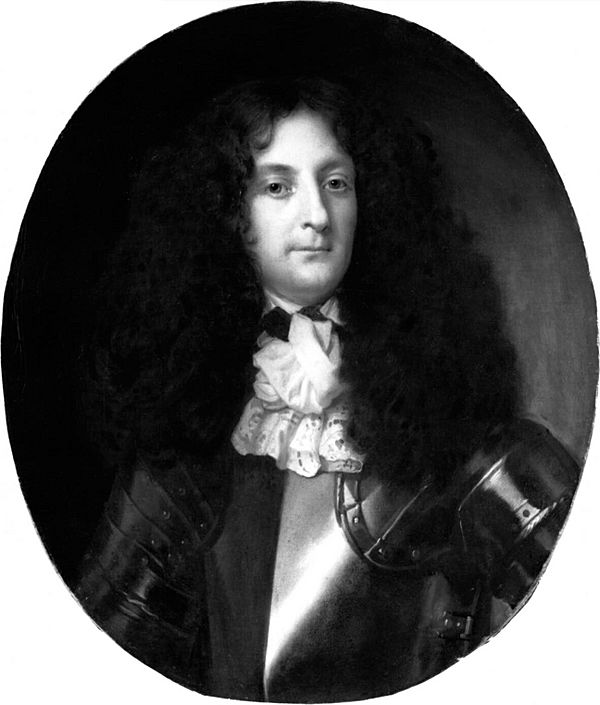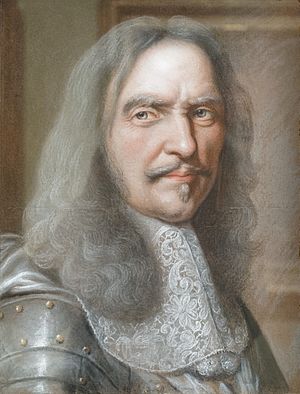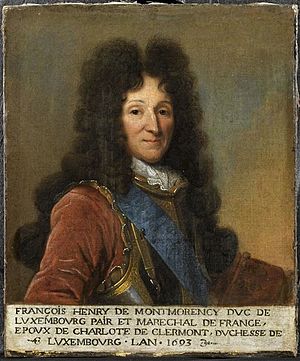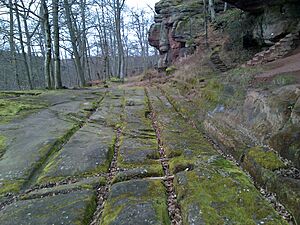George Hamilton, Comte d'Hamilton facts for kids
Quick facts for kids
Sir George Hamilton
|
|
|---|---|
| Called "Comte d'Hamilton" | |
|
Detail from the portrait below
|
|
| Died | 1 June 1676 Col de Saverne, France |
| Spouse(s) | Frances Jennings |
| Issue Detail |
Elizabeth, Frances, & Mary |
| Father | George Hamilton |
| Mother | Mary Butler |
Sir George Hamilton (died 1676) was an Irish soldier who served both England and France. He was also a courtier, meaning he spent time at the royal court of King Charles II in Whitehall, London.
At Whitehall, he was a favorite of the King. He married Frances Jennings, who was a maid of honour to the Duchess of York. His brother, Anthony Hamilton, wrote about him in his famous book, Mémoires du comte de Grammont.
George Hamilton started his military career in the Life Guards. But in 1667, he was removed because he was Catholic. After that, he joined the French army. He led English soldiers and then an Irish regiment in the Franco-Dutch War (1672–1678). He fought in major battles like Sinsheim and Entzheim in 1674. He was also at the Sasbach (1675), where his commander, Turenne, was killed. George Hamilton died in 1676 during a battle at the Col de Saverne in France. He was a Maréchal de camp, which is like a major-general. He was known as "Comte d'Hamilton," but it's not certain if Louis XIV officially made him a count.
| Family tree | ||||||||||||||||||||||||||||||||||||||||||||||||||||||||||||||||||||||||||||||||||||||||||||||||||||||||||||||||||||||||||||||||||||||||||||||||||||||||||||||||||||||||||||||||||||||||||||||||||||||||||||||||||||||||||||||||||||||||||||||||||||||||||||||||||||||||||||||||||||||||||||||||||||||||||||||||||||||||||||||||||||||||||||||||||||||||||||||||||||||||||||||||||||||||||||||||||||||||||||||||||||||||||||||||||||||||||||||||||||||||||||||||||||||||||||||||||||||||||||||||||||||||||||||||||||||||||||||||||||||||||||||||||||||||||||||||||||||||||||||||||||||||||||||||||||||||||||||||||||||||||||||||||||||||||||||||||||||||||
|---|---|---|---|---|---|---|---|---|---|---|---|---|---|---|---|---|---|---|---|---|---|---|---|---|---|---|---|---|---|---|---|---|---|---|---|---|---|---|---|---|---|---|---|---|---|---|---|---|---|---|---|---|---|---|---|---|---|---|---|---|---|---|---|---|---|---|---|---|---|---|---|---|---|---|---|---|---|---|---|---|---|---|---|---|---|---|---|---|---|---|---|---|---|---|---|---|---|---|---|---|---|---|---|---|---|---|---|---|---|---|---|---|---|---|---|---|---|---|---|---|---|---|---|---|---|---|---|---|---|---|---|---|---|---|---|---|---|---|---|---|---|---|---|---|---|---|---|---|---|---|---|---|---|---|---|---|---|---|---|---|---|---|---|---|---|---|---|---|---|---|---|---|---|---|---|---|---|---|---|---|---|---|---|---|---|---|---|---|---|---|---|---|---|---|---|---|---|---|---|---|---|---|---|---|---|---|---|---|---|---|---|---|---|---|---|---|---|---|---|---|---|---|---|---|---|---|---|---|---|---|---|---|---|---|---|---|---|---|---|---|---|---|---|---|---|---|---|---|---|---|---|---|---|---|---|---|---|---|---|---|---|---|---|---|---|---|---|---|---|---|---|---|---|---|---|---|---|---|---|---|---|---|---|---|---|---|---|---|---|---|---|---|---|---|---|---|---|---|---|---|---|---|---|---|---|---|---|---|---|---|---|---|---|---|---|---|---|---|---|---|---|---|---|---|---|---|---|---|---|---|---|---|---|---|---|---|---|---|---|---|---|---|---|---|---|---|---|---|---|---|---|---|---|---|---|---|---|---|---|---|---|---|---|---|---|---|---|---|---|---|---|---|---|---|---|---|---|---|---|---|---|---|---|---|---|---|---|---|---|---|---|---|---|---|---|---|---|---|---|---|---|---|---|---|---|---|---|---|---|---|---|---|---|---|---|---|---|---|---|---|---|---|---|---|---|---|---|---|---|---|---|---|---|---|---|---|---|---|---|---|---|---|---|---|---|---|---|---|---|---|---|---|---|---|---|---|---|---|---|---|---|---|---|---|---|---|---|---|---|---|---|---|---|---|---|---|---|---|---|---|---|---|---|---|---|---|---|---|---|---|---|---|---|---|---|---|---|---|---|---|---|---|---|---|---|---|---|---|---|---|---|---|---|---|---|---|---|---|---|---|---|---|---|---|---|---|---|---|---|---|---|---|---|---|---|---|---|---|---|---|---|---|---|---|---|---|---|---|---|---|---|---|---|---|---|---|---|---|---|---|---|---|---|---|---|---|---|---|---|---|---|---|---|---|---|---|---|---|---|---|---|---|---|---|---|---|---|---|---|---|---|---|---|---|---|---|---|---|---|---|---|---|---|---|---|---|---|---|---|---|---|---|---|---|---|---|---|---|---|---|---|---|---|---|---|---|---|---|---|---|---|---|---|---|
|
||||||||||||||||||||||||||||||||||||||||||||||||||||||||||||||||||||||||||||||||||||||||||||||||||||||||||||||||||||||||||||||||||||||||||||||||||||||||||||||||||||||||||||||||||||||||||||||||||||||||||||||||||||||||||||||||||||||||||||||||||||||||||||||||||||||||||||||||||||||||||||||||||||||||||||||||||||||||||||||||||||||||||||||||||||||||||||||||||||||||||||||||||||||||||||||||||||||||||||||||||||||||||||||||||||||||||||||||||||||||||||||||||||||||||||||||||||||||||||||||||||||||||||||||||||||||||||||||||||||||||||||||||||||||||||||||||||||||||||||||||||||||||||||||||||||||||||||||||||||||||||||||||||||||||||||||||||||||||
Contents
Who was George Hamilton?
George Hamilton was likely born in Ireland in the late 1630s or early 1640s. His father was George Hamilton, a Scottish nobleman. His father became a Baronet of Donalong and Nenagh in 1660. The Donalong land was given to his grandfather during the Plantation of Ulster, a time when Scottish and English settlers moved to Ireland.
George's mother was Mary Butler, from an old Irish family called the Butlers. They were known as "Old English" because their ancestors came from England with King Henry II in 1177. Mary Butler was the sister of the famous 1st Duke of Ormond.
George had eight brothers and sisters, including James, Elizabeth, and Anthony. His parents were Catholic, but some of his relatives were Protestant. His family's religion played a big part in his life and career.
What was George Hamilton's early life like?
Growing up during the Irish wars
George's father, Sir George Hamilton, was a soldier for the Duke of Ormond. Ormond was the King's representative in Ireland. His father fought in the Irish Confederate Wars (1641–1648) and the Cromwellian conquest of Ireland (1649–1653). These were difficult times in Ireland.
During these wars, young George stayed with his mother and siblings at Nenagh Castle. Even though his father fought for the King, his family was Catholic and generally safe in areas controlled by Irish Catholics.
In 1650, Nenagh Castle, where his family lived, was attacked and captured by the Parliamentarian army.
Life in exile
In 1651, George's family had to leave Ireland and go to France. They followed the Duke of Ormond and King Charles II, who were also in exile. Young George, who was about 10 years old, became a page for King Charles II. This meant he served the King in his court.
The King and his court moved around Europe during their exile. They lived in Paris, then Cologne, Brussels, Bruges, and Antwerp. George stayed with the King through these moves.
Returning to England
When King Charles II returned to England in 1660, a time known as the Restoration, George Hamilton went with him. He joined the Life Guards, a special military unit created by the King. George was an officer in the King's own troop.
Besides his military duties, George spent a lot of time at the royal court in Whitehall. He and his brothers and sister were close to the King. George was known for being charming and popular at court. He married Frances Jennings in 1665. The King approved of their marriage and gave them money each year.
George Hamilton's Family
George and Frances Hamilton had four daughters:
- Elizabeth (1667–1724): She married Richard Parsons, the 1st Viscount Rosse.
- Frances (died 1751): She married Henry Dillon, 8th Viscount Dillon.
- Mary (died 1736): She married Nicholas Barnewall, 3rd Viscount Barnewall.
- Henrietta: Not much is known about her.
Elizabeth was born in England and raised Protestant. Her younger sisters were born in France and raised Catholic. All three older daughters married Irish noblemen called viscounts, which is why they were known as the "three viscountesses."
What was George Hamilton's military career like?
Fighting for England
In 1665, the Second Anglo-Dutch War (1665–1667) began. George Hamilton volunteered for the Royal Navy and fought in the naval battle of Lowestoft, where England won.
However, in 1667, the political situation in England became difficult for Catholics. King Charles II had to remove Catholics from his Life Guards if they refused to take a special oath. George Hamilton was one of the officers dismissed.
Serving France
After leaving the English army, George Hamilton moved to France in 1668. King Charles II arranged for him to join the French army under Louis XIV. George became a captain-lieutenant in a special company of soldiers. He was knighted by the King before he left England. His wife also moved to France and became Catholic.
In 1671, Hamilton raised a new infantry regiment (a large group of soldiers) in Ireland for the French army. Many famous officers joined his "Hamilton's Regiment," including Patrick Sarsfield and George's younger brothers, Anthony and Richard.
In 1672, France and England declared war on the Dutch Republic. This started the Franco-Dutch War (1672–1678). Hamilton spent the rest of his life fighting for France in this war. For the first three years, he served under the famous French general, Marshal Turenne.
Hamilton's regiment fought in many battles. In 1674, he commanded three battalions at the Battle of Sinsheim. In October, he fought at the Battle of Entzheim in France, where he and his brother Anthony were wounded.
In 1675, George Hamilton was with Turenne when the Marshal was killed at the Sasbach. After Turenne's death, the French army retreated. Hamilton and his Irish soldiers were praised for their bravery in protecting the army during the retreat at the Battle of Altenheim.
In February 1676, George Hamilton was promoted to maréchal de camp, which is like a major-general, because of his excellent service.
What does "Comte d'Hamilton" mean?
French records often called George Hamilton "Comte d'Hamilton," which means "Count of Hamilton." This might have been because the French thought he was a nobleman, or it was a polite way to address him. Some sources suggest he was made a count by Louis XIV in 1676, but there's no clear record of this. He didn't own any land in France that would make him a count of a specific place.
How did George Hamilton die?
George Hamilton was killed in battle on June 1, 1676. He was leading the rear-guard of the French army at the Col de Saverne (a mountain pass) in France. The French army was retreating, and imperial troops were chasing them. Hamilton died fighting to protect his soldiers.
After his death, his younger brother Anthony took over the title "Comte d'Hamilton." However, King Charles II of England wanted Thomas Dongan to lead Hamilton's regiment instead.
| Timeline of George Hamilton's Life | ||
|---|---|---|
| His exact birth date is not known, so ages are estimates. | ||
| Age (approx.) | Date | Event |
| 0 | 1640s | Born in Ireland. |
| 10 | 1651 | Moved to France with his family; became a page for King Charles II. |
| 20 | 1660 | Returned to England with King Charles II; joined the Life Guards. |
| 25 | 1665 | Married Frances Jennings. |
| 25 | June 3, 1665 | Fought in the naval Battle of Lowestoft. |
| 27 | September 28, 1667 | Removed from the Life Guards because he was Catholic. |
| 28 | February 1, 1668 | Left England for France. |
| 31 | 1671 | Formed an Irish infantry regiment for the French army. |
| 34 | June 16, 1674 | Fought at the Battle of Sinsheim. |
| 34 | October 6, 1674 | Fought at the Battle of Entzheim and was wounded. |
| 35 | July 27, 1675 | Fought at the Battle of Sasbach, where Marshal Turenne was killed. |
| 35 | August 1675 | Fought bravely in the rearguard action at the Battle of Altenheim. |
| 36 | June 1, 1676 | Killed in battle at the Col de Saverne. |







